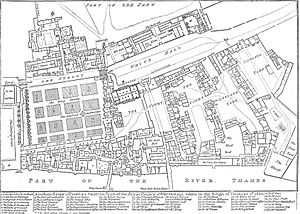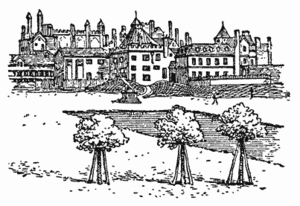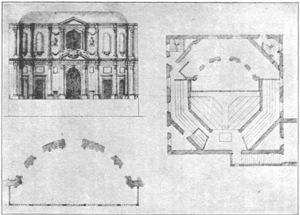Cockpit-in-Court facts for kids
The Cockpit-in-Court was an early theatre in London. It was part of the huge Palace of Whitehall, which was next to St. James's Park in Westminster. Today, a government building at 70 Whitehall stands on its site.
Contents
A Royal Entertainment Spot
The Cockpit-in-Court was first built by King Henry VIII. He built it after taking over Cardinal Wolsey's home, York Place, in 1529. Henry VIII loved entertainment! He added many fun buildings to his palace. These included a real tennis court, a bowling alley, and a place for jousting called a tiltyard. The Cockpit was originally used for cockfighting, where roosters fought each other.
With these new additions, the Palace of Whitehall became the main home for the Tudor and Stuart kings and queens of England. The older Palace of Westminster was then used mostly for official ceremonies and government work.
From Cockfighting to Theatre
During the time of King James I (known as the Jacobean era), the Cockpit stopped being used for cockfighting. Instead, it became a private theatre. It was also used as rooms for people who worked for the Royal Family.
In 1629, King Charles I had the building redesigned. The famous architect Inigo Jones changed it into a private theatre. It was used for staging special plays called court masques, which were fancy performances for the King and his guests. This was the second cockpit that Jones had turned into a theatre. He had also worked on the Cockpit Theatre in Drury Lane after it was damaged by fire in 1617.
A New Era for Theatre
During a time in England called the Interregnum, many theatres were closed. But after this period, the Cockpit-in-Court was used again by King Charles II. In 1662, it was updated. A new dressing room was added especially for female actors. Having women perform on stage was a new and exciting idea back then! The walls of this dressing room were covered in green fabric called baize. Some people think this is why dressing rooms for actors are still sometimes called "green rooms" today.
The famous diarist Samuel Pepys wrote in his diary about going to see several plays at the Cockpit.

Royal Residents and Government Use
In 1680, important officials like the Master of the Great Wardrobe lived in the Cockpit. Later, King Charles II gave the Cockpit to his niece, Princess Anne, in 1683. Anne later became Queen.
An important event happened at the Cockpit in 1688. Princess Anne and her close friend, Sarah, Lady Churchill, secretly escaped from here. They were worried about being arrested. This happened at the start of the Glorious Revolution, when King James II was replaced by William of Orange. Both their husbands had decided to support William instead of James II. Sarah and Anne quickly fled to Nottingham.
Most of the Palace of Whitehall was destroyed by a huge fire in 1698. Luckily, the Cockpit, along with the famous Banqueting House (also designed by Inigo Jones), survived the fire. After the fire, King William III moved his home to nearby St James's Palace. The area where Whitehall Palace stood was rebuilt with government offices and homes.
The Cockpit building was then used to house government officials. The HM Treasury (the government department that handles money) used it first. They stayed there until 1734, when they moved to a new building. Later, in the late 1700s, the Foreign Office (which deals with other countries) used the building. After that, the Privy Council (a group of advisors to the monarch) used it as a meeting room for legal matters.
Today, the building at 70 Whitehall is used by the Cabinet Office, another important government department. A passage inside this building, called Cockpit Passage, follows the path of the old tennis courts and leads to where the original Cockpit lodgings were. There's even a special gallery on the ground floor decorated with pictures of fighting cocks and a model of the old Whitehall Palace.
It's important not to confuse the Cockpit-in-Court with Cockpit Steps. These steps are nearby in St James Park and lead up from Birdcage Walk past the site of another royal cockpit in Old Queen Street.
Reconstructions
A copy of the Cockpit-in-Court theatre, based on Inigo Jones's 1629 plans, has been built. It is part of the Shakespeare North complex in Prescot, Merseyside. This project was inspired by the historical Prescot Playhouse, which existed between the 1590s and 1609. However, no original plans of that older theatre still exist.



